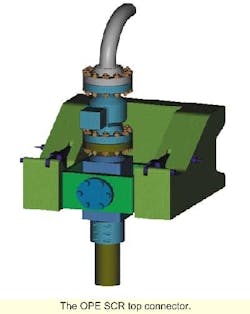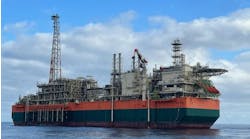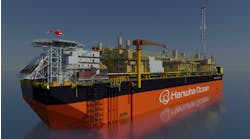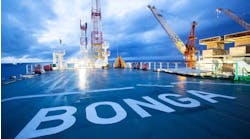SCR top connector
The OPE SCR top connector.
PE is introducing a new steel catenary riser top connector (SCR-TC) for use in deepwater. The new SCR-TC offers improved performance and safety over existing systems by eliminating elastomers from the multiple duties of high load absorption, flexural cycling, and high-pressure containment of petroleum liquids and gases
OPE said the SCR-TC improves the basic application purpose of increased multi-directional angular movement, increased field installation durability, and improved fluid transfer without flashing. The new design also reduces top SCR bending moments that occur in present designs. Other benefits include:
- All-metal load carrying construction
- Three-axis of rotation
- Increased excursion angles
- Standardized design
- Installation flexibility
- Layaway capabilities
- Increased angular motion (35° out of plane, 90° in plane)
- Improved maintenance/field service
- Higher pressure rating
- Higher temperature rating (-20° to +350°
- Standardized hang-off porch size range
- All elastomers can be isolated with safety valves.
Shell uses expandables in ultra-deep target
Shell Exploration & Production Company (SEPCo) has installed a second solid expandable tubular (SET) system in an ultra-deepwater well in Alaminos Canyon 557, utilizing the R&B Falcon Deepwater Nautilus semisubmersible drilling rig. This is the world's first well to have multiple openhole SET installations.
Enventure Global Technology installed the 1,521-ft 9-5/8-in. openhole expandable liner system inside 11-3/4-in. casing, further increasing overall length-of-hole with negligible reduction in casing diameter, thus enabling Shell to explore the deeper objectives of this ultra-deepwater well.
The first SET system was run in the Alaminos Canyon 557 well in September 2000: a 1,186-ft 13-3/8-in. X 16-in. openhole expandable liner system expanded into 16-in. base casing. The second SET installation, a 9-5/8-in. by 11-3/4-in. expandable liner system, is the first expandable openhole system of its size ever installed, as well as the world's deepest SET installation (measured depth of more than 16,000 ft).
The 1,521-ft system was expanded in about five hours, using propagation pressures of 2,000 psi. The expandable liner system was pressure-tested at 1,500 psi for 30 minutes with no leaks, per operator and MMS requirements. Post-expansion internal diameter (ID) of the 9-5/8-in. expandable liner was 9.978-in. (compared to a pre-expansion diameter of 8.921 in.), while post expansion yield and collapse are estimated at 4,430 psi and 1,270 psi, respectively (based on prior surface tests).
The 9-5/8-in. 36.0 lbs/ft liner, expanded 11.8% into 11-3/4-in. base casing and open hole, exhibited a 4% reduction in overall length. The 9-5/8-in. by 11-3/4-in. system is the 19th commercial solid expandable tubular installation completed by Enventure - six openhole liner systems and 13 cased-hole systems. To date, Enventure has expanded a total of 16,116 tubular ft and 528 connections. Enventure Global Technology was organized and owned by Halliburton Energy Services and Shell Technology Ventures.
Mexisub riser repair
Mexisub S.A. de C.V. recently completed a series of repairs on six production risers for Pemex in the Bay of Campeche. The risers had experienced deterioration of the mechanical connection between the riser and the J-tube. The repairs were performed at water depths ranging between 127 and 168 ft. The six risers had diameters of 20 in., 24 in., and 36 in.
To perform the repairs, Mexisub employed a patented sleeve system technology. The process involves encasing the mechanical connection with a meter-long, epoxy-filled sleeve. The Mexisub Flexible Habitat with a nitrogen environment allowed hyperbaric welding to be performed on the upper and lower transition cone, and the longitudinal welds of the sleeve. All the repairs were made on the risers without suspending production.
Mexisub said the sleeve system holds a type approval certificate from DNV as a permanent repair for risers and pipelines. The welding procedures were approved under DNV guidelines. Pemex received re-certification of the risers from DNV following completion of the repair.
Seafloor processing study
In February, BP and Chevron agreed to form an alliance with Kværner and ABB to perform a collaborative study of the challenges associated with advanced seafloor processing technology. The focus of the study is deepwater oil and gas reserves. Work was expected to be complete by the end of March, but results are not yet public.
The goal is to analyze ways that seafloor separation equipment can be standardized into compact modules that could be placed on the seafloor and operated by remote control. Such a solution would be a sea change for offshore production, which currently relies on floating facilities that are expensive to construct, install, and operate.
The majority of production that comes from many offshore fields is water. Just eliminating the need to pump this phase of the fluid would reduce topside requirements dramatically. This would also reduce the handling cost of separating, processing, and disposing of produced water.
The study will work on identifying the level of investment required to close the gaps between current technology and technologies required for seafloor processing in deepwater. Project teams are working on this multinational study in Norway, the UK, and the US. The benefits of this study were listed by the participants in the initial announcement and are as follows:
- New, cost-effective subsea processing facilities
- Increased oil recovery over traditional field development options such as floating production storage and offloading
- Spin-off technologies in the area of oil and gas treatment that could improve the operation of conventional facilities
- Provide the necessary foundation to continue collaboration that could lead to further spreading in this area of technology.
Deep Blue delivered
Coflexip Stena Offshore (CSO) announced that its ultra-deepwater vessel CSO Deep Blue is now in the Netherlands being fitted with pipelay equipment. The pipelay system will allow the vessel to lay rigid pipe (reeled or J-Lay), flexible pipe, and umbilical down to 8,200 ft water depth. The vessel is scheduled to begin operations this summer after completing sea trials with the new pipelay system.
The vessel's first job will be the installation of the export pipeline systems on the Boomvang and Nansen field developments located in 3,600 ft water depths in the Gulf of Mexico. These operations will be handled out of CSO's new spoolbase located in Mobile, Alabama.




